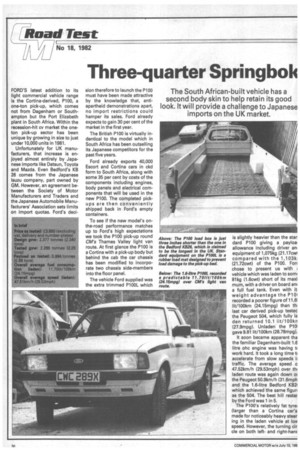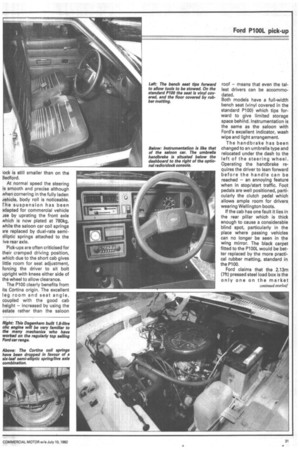Three-quarter Springbok
Page 28

Page 29

Page 30

If you've noticed an error in this article please click here to report it so we can fix it.
The South African-built vehicle has a second body skin to help retain its good look. It will provide a challenge to Japanese imports on the UK market.
FORD'S latest addition to its light commercial vehicle range is the Cortina-derived, P100, a one-ton pick-up, which comes not from Dagenham or Southampton but the Port Elizabeth plant in South Africa. Within the recession-hit cv market the oneton pick-up sector has been unique by growing in size to just under 10,000 units in 1981.
Unfortunately for UK manufacturers, that increase is enjoyed almost entirely by Japanese imports like Datsun, Toyota and Mazda. Even Bedford's KB 26 comes from the Japanese Isuzu company, part owned by GM. However, an agreement between the Society of Motor Manufacturers and Traders and the Japanese Automobile Manufacturers' Association sets limits on import quotas. Ford's deck sion therefore to launch the P100 must have been made attractive by the knowledge that, antiapartheid demonstrations apart, no import restrictions could hamper its sales. Ford already expects to gain 30 per cent of the market in the first year.
The British P100 is virtually indentical to the model which in South Africa has been outselling its Japanese competitors for the past five years.
Ford already exports 40,000 Escort and Cortina cars in ckd form to South Africa, along with some 35 per cent by costs of the components including engines, body panels and electrical components that will be used in the new P100. The completed pickups are then conveniently shipped back in Ford's empty containers.
To see if the new model's onthe-road performance matches up to Ford's high expectations we took the P100 pick-up round CM'S Thames Valley light van route. At first glance the P100 is a Cortina with a pick-up body but behind the cab the car chassis has been modified to incorporate two chassis side-members into the floor panel.
The vehicle Ford supplied was the extra trimmed P100L which is slightly heavier than the star dard P100 giving a payloal allowance including driver ani equipment of 1,075kg (21.17cw1 compared with the 1,103k! (21.72cvvt) of the P100. For( chose to present us with vehicle which was laden to soml 81kg (1.6cwt) short of its maxi mum, with a driver on board am a full fuel tank. Even with it: weight advantage the P101 recorded a poorer figure of 11.61 lit/100km (24.15mpg) than till last car derived pick-up tested the Peugeot 504, which fully la den returned 10.1 lit/100kn (27.9mpg). Unladen the P101 gave 9.81 lit/100km (28.78mpg).
It soon became apparent tha the familiar Dagenham-built 1.6 litre ohc engine was having t work hard. It took a long time ti accelerate from slow speeds ii traffic. The average speed o 47.52km/h (29.53mph) over till laden route was again down oi the Peugeot 50.9km/h (31.6mph and the 1.6-litre Bedford KB2I which achieved the same figun as the 504. The best hill restar by the Ford was 1 in 5.
The P100's relatively fat tyre: (larger than a Cortina car's made for noticeably heavy steer ing in the laden vehicle at lov speed. However, the turning cir cle on both leftand right-hanc lock is still smaller than on the Bedford, At normal speed the steering is smooth and precise although when cornering in the fully laden vehicle, body roll is noticeable. rhe suspension has been adapted for commercial vehicle ice by uprating the front axle which is now plated at 780kg, while the saloon car coil springs Ire replaced by dual-rate semi311iptic springs attached to the ive rear axle.
Pick-ups are often criticised for their cramped driving position, which due to the short cab gives little room for seat adjustment, forcing the driver to sit bolt upright with knees either side of the wheel to allow clearance.
The P100 clearly benefits from its Cortina origin. The excellent leg room and seat angle, coupled with the good cab height — increased by using the estate rather than the saloon roof — means that even the tallest drivers can be accommodated.
Both models have a full-width bench seat (vinyl covered in the standard P100) which tips forward to give limited storage space behind. Instrumentation is the same as the saloon with Ford's excellent indicator, wash wipe and light arrangement.
The handbrake has been changed to an umbrella type and relocated under the dash to the left of the steering wheel. Operating the handbrake requires the driver to lean forward before the handle can be reached — an annoying feature when in stop/start traffic. Foot pedals are well positioned, particularly the clutch pedal which allows ample room for drivers wearing Wellington boots.
If the cab has one fault it lies in the rear pillar which is thick enough to cause a considerable blind spot, particularly in the place where passing vehicles can no longer be seen in the wing mirror. The black carpet fitted to the P1001.. would be better replaced by the more practical rubber matting, standard in the P100.
Ford claims that the 2.13m (7ft) pressed steel load box is the only one on the market continued overleaf with a double skin, thereby protecting the outer panels from load damage and preserving second hand values. The interior vertical walls are strengthened by lateral ribs, while the wheel arches are neatly squared in helping to retain load stability.
The full-width tailgate can be retained by chains up to 90 degrees giving an extra 350mm (133/4in) load length, or fully dropped. The floor area of 2.86sqm (30.86sqft) is greater than the Peugeot's 2.70sqm (29.1sqft), but below its main Japanese rivals — the Mazda B1800 3.1sqm (34sqft); the Toyota Hi-Lux 3.1 2sqm (33.5sqft) and the Datsun 720 3.27sqm (35.2sqft).
A removable cab protector allows long loads to be mounted over the cab and the folding stays help to secure ladders.
Our vehicle showed good braking efficiency on the test track pulling up straight from all speeds and all wheels locked when braking from 30 and 40 mph.
Summary
The Cortina-derived P100 will surely appeal to the nationwide army of jobbing builders, plumbers and gardeners who make up the single pick-up buyers' market. The engine, driveline and cab are all familiar components based on a highly successful car range. With the formidable Ford marketing organisation in support, sales of the new pick-up could well take off and prove the manufacturer's ambitious plan for its first year sales to be no pipe dream.












































